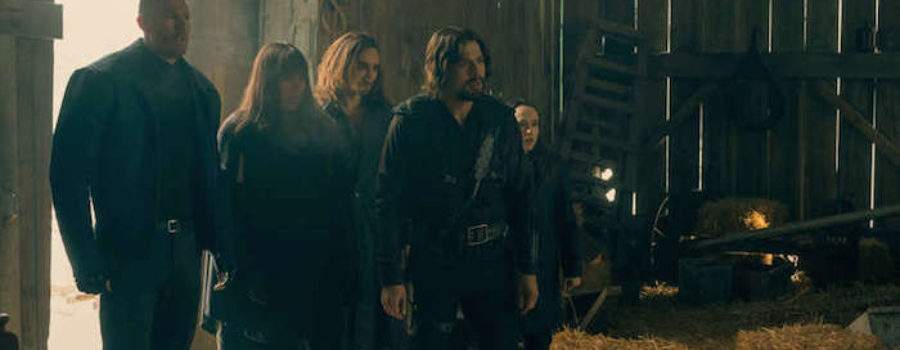[Published at Slash Film] Like its debut season, The Umbrella Academy’s second season is oozing with historical, sociopolitical, and pop culture references, and nods to Gerard Way’s comic book source material. However, in the beginning of season 2, in each of the scenes during which the seven gifted children of The Academy travel back to the 1960s, a Hammer Film Production B horror flick, except for The Sergeant was a Lady, plays at the Avon Theater in Dallas, Texas, setting the tone for the rest of the season. And what a tone Hammer films have.
This post contains spoilers for The Umbrella Academy season 2.
Watching a Hammer film is an entirely unique experience. The viewer is transported to a world of suspended disbelief. However, beneath the surface of these classic films lie a simultaneous, relatable charm. Like all good horror, Hammer films blend real life trauma with fantasy, injecting them with socially relevant themes that urge the viewer to ponder the human condition. And they expertly utilized talented actors such as Christopher Lee and Peter Cushing in recurring roles to further establish a comfort of familiarity for their audiences.
Tim Burton, a diehard Hammer fan, created an homage to Hammer films with Sleepy Hollow. The film’s cinematographer, Emmanuel Lubezki, said in its production notes, “It’s more like a ‘fantastic tale,’ not a realistic historical reconstruction. We have to enhance certain elements to accentuate the ‘fantastic.’ The Hammer films did it without knowing they were doing it. We do it because we like it.”
Lubezki brings up an enduring point. Many horror auteurs in follow decades, Mario Bava and Dario Argento included, would emulate The Hammer style, with a combination exaggerated sets, distinctive, unmistakable sound effects that transport the viewer through the silver screen, and genuine performances to capture an intangible world seemingly just out of reach of our reality.
The Umbrella Academy’s creator, Steve Blackman, and developer, Jeremy Slater, continue the Hammer homage tradition in Season 2. To launch the season, Blackman and Slater show the local, second-run cinema screen Curse of the Undead when Klaus (Robert Sheehan) and Ben (Justin H. Min) arrive back in time, The Curse of the Werewolf when Allison (Emmy Raver-Lampman) does, The Sergeant Was a Lady when Luther (Tom Hopper) does, and The Kiss of the Vampire when Diego (David Castañeda), Vanya (Ellen Page), and, finally, Number 5 (Aidan Gallagher) arrive, with 5 showing up just before the nuclear apocalypse (Blackman and Slater significantly amp up the Cold War tensions in The Umbrella Academy’s sophomoric season).
Season 2 frequently references each of these films and their repeated, growing significance throughout, and subtly pays homage to other Hammer Film Productions such as The Mummy and The Legend of the 7 Golden Vampires, stylistically and thematically.
All of these films, except The Sergeant Was a Lady (one of these films is pointedly not like the other), are about the undead, portraying these “afflictions” as a social diseases affecting those who associate with certain lifestyles, whether inherently or through false pretenses; the undead, in this case werewolves and vampires, are allegories for both the immigrant experience and the excessive wealthy lifestyle – two opposing perspectives and places on the privilege pendulum. If there is one thing all of these films have in common, it’s that they reflect a collective societal anxiety. Each title screened at the Avon Theater and its subject matter mainly refers to the character and their struggle with which they are associated, however, the films bleed into other characters as well, and generally apply to the show, as a whole.
Curse of the Undead
Arguably the most far-fetched Hammer film, this is a horror B movie western hybrid. Taking place in a rancher and farmer pre-apocalypse, during which water is a scarce commodity, The Curse of the Undead is about a man, Doc Carter, who must defend his ranch from both a vindictive former nemesis, and an elusive new enemy. The title alone acknowledges that Klaus has always viewed his ability to communicate and interact with the dead as a curse. He injects himself with poison to dull the voices, damaging his psyche. In turn, Ben feels cursed to be stuck with Klaus, who mistreats him, in a purgatory, of sorts, having missed his opportunity to walk towards the light.
Thematically and narratively, The Curse of the Undead parallels Vanya’s storyline most overtly, which ignites the flames of the series, and each character’s arc, ultimately meeting at the climactic location of Sissy’s (Marin Ireland) farm for an explosive conclusion.
Aesthetically, the palms at Klaus’ mansion, The Academy, the sauna where the handler finally meets the Swedes, and the Tiki Lounge at 1624 Magnolia Street, wrapped in decorative pottery, all resemble each other. This is one of many inanimate objects that mysteriously link The Handler (Kate Walsh) and Sir Reginald (Colm Feore). More on that in The Kiss of the Vampire section.
The Curse of the Werewolf
Being a werewolf in this film is considered a curse. Not only was the werewolf born out of a violent act, but he is the son of lower class citizens – even before he is revealed as the werewolf, he is never fully accepted into society. For over 400 years, for many black people in America, simply existing has been deemed a curse by white America. In America, the word “black” used to be synonymous with “evil” and “unholy” in its dictionaries. This association, and our country’s troubled history with white supremacy, has also carried a heavy “curse,” if you will, for people of color in America. They are targeted and hunted like the werewolf in The Curse of the Werewolf. Hunting black people for existing was a problem that Allison is placed at the forefront of during the civil rights movement throughout the 1960s, and it is still a problem today that the human race is trying curb by emboldening the Black Lives Matter movement.
Blackman and Slater literally reference the film with Diego when Lila (Ritu Arya) refers to him as “Wolf Man” after he tells her he’s a “lone wolf.” His nickname, coupled with his new hair, resemble the werewolf of the Hammer film, which was inspired by Wolf Man in 1941. In The Curse of the Werewolf, love is thought to be the only cure to the affliction. Regarding Diego, love distracts both him and his lover from their missions, which are both self-destructive. Diego’s mission leads him to die in the apocalypse, and Lila, an experiment, is considered expendable by The Handler. In a way, love is the cure to both Diego and Allison’s issues, as the love that Allison and her husband share keep them strong during the most trying times of prejudice.
The Sergeant Was a Lady
As aforementioned, The Sergeant Was a Lady doesn’t fit the pattern. The mold. It could be a misdirect. Yet, like The Handler and the Commission she runs, it sticks out like sore thumb among the other aesthetic flourishes of The Umbrella Academy. The film is not only a reference to the internal politics of the Commission, and how it not reflects the external McCarthyism paranoia of the 1950s, but also America’s increasing Cold War tension with the Soviet Union.
In Season 2, Carmichael takes over the Commission and demotes The Handler. The internal power struggle of the commission reflects the battle of the sexes narrative within Sergeant Was a Lady, and it’s also emblematic of the power struggle within our government during that time – in The Umbrella Academy, JFK was assassinated by the Majestic 12, a real-life group of military and government leaders, flaring the inflammation of the conspiracy theory community, whose exhaustive research gives slightly more credibility to the JFK assassination inconsistencies than other, more far-fetched government theories. Our government was worried that JFK’s flexible response foreign policy was too soft on communism, his liberal views on war and civil rights too divisive. This isn’t an entirely inaccurate depiction of LBJ’s views of some of JFK’s policies at the time.
The Kiss of the Vampire
Diego. Vanya. Number 5. What do they all have in common? At some point or another in The Umbrella Academy, the three characters have almost or have caused the apocalypse. The kiss of a vampire is the kiss of death, after which only impending doom faces us – the presence of vampires threatens the population of human life on earth to the point of extinction. However, the most important theme, still, shared between The Kiss of the Vampire and Season 2 of The Umbrella Academy is that of the societal phenomenon of cult and what it tells humanity about our own nature.
The Kiss of the Vampire could be used from the outsider’s perspective. The ignorant villain. Sissy’s husband and Harlan’s (Justin Paul Kelly) father (Stephen Bogaert) views Vanya as a threat to his family and way of life; to him, his wife and child have been kidnapped by something, as he refers to their lesbian affair as “unnatural,” akin to the effect of a cult, in his mind, with Vanya as the collective group brainwashing his wife. She also gives Harlan some of her power in order to save his life. In the Season 1 finale flashback, Sir Reginald releases the same energy seen that Vanya revives Harlan with in Season 2, which Harlan is seen still possessing at the end of the season. Not only does this allude to the fact that Sir Reginald created the 43 immaculate conceptions in 1989, but that Harlan is now reborn gifted, his power causing the Commission and the children of The Academy to finally clash. Further, Harlan is seen with a wooden red sparrow toy in Season 2, foreshadowing The Sparrow Academy in 2019. Could adult Harlan, now able to control his powers, like Vanya, be associated with this new timeline, and The Sparrow Academy, somehow?
Many whites thought of the civil rights movement as something of an immoral cult, where it was frowned upon for black people and white people, in action and solidarity, to gather for fear of mobilization against injustice. Allison is consistently faced with microaggressions and verbal and physical assault.
Diego’s lover was, in fact, actually kidnapped by a cult – the Commission – and subsequently brainwashed to believe that the seven children were her enemies instead of The Handler. Diego, with a hero complex like Professor Zimmer (Clifford Evans) in The Kiss of the Vampire, to save her. Number 5 was “abducted” and brainwashed by this cult as a young child as well, growing up to be a slightly sociopathic killer.
However, if the Commission is a cult, so is The Academy. They are, by all accounts, two sides of the same coin. Both the handler and Sir Reginald share similar qualities. Diego mentions to the handler’s daughter during one of their covert missions after their asylum breakout, “sounds like something my father used to say.” The Majestic 12 is also very much a cult of powerful figures. They were real people. Military leaders, government officials, and wealthy businesspeople. Diego calls them Sir Reginald’s group of lizardpeople (they’re famous for searching for alien aircraft remains). When Sir Reginald kills the Majestic 12, he unzips a human suit to reveal a reptilian skin and appearance. The Handler wears two lizard lapel pins when she hands 5 the briefcase in order to gather his other siblings in Dallas and get back to 2019, signifying that she may be of the same origin as Sir Reginald – two lizards, two people. The Handler also wears a leather jacket with scaled shoulder pads in the finale.
All things considered, The Handler is a new character not present in the original comics. If she isn’t part of Sir Reginald’s species, she at least knows about him and the significance of the children, having found at least one (Lila) herself.
The Mummy
In The Mummy, after spending an extended period of time at a mental hospital after brining the mummy back to life in Princess Ananka’s tomb for reading the scroll of life, Stephen (Felix Aylmer) is visited by John (Cushing), who accompanied him on the expedition. Stephen becomes emotional when John tries to remind him of the past and warns him that the mummy will return. Not only does this scene mirror Diego being institutionalized, but John visiting him is reminiscent of Number 5’s visit, during which he warns him of the world ending. Diego breaking out mirrors The Mummy (Lee) breaking in to kill Stephen. Blackman and Slater cleverly reverse the power dynamics of the iconic Mummy scenes.
The Legend of the 7 Golden Vampires
The Legend of the 7 Golden Vampires marks Cushing’s last effort in his legendary run as Van Helsing in the Hammer films. In the film, there is a legend of seven ancient Chinese vampires, with one supposedly dead – hunted for being in the wrong place, at the wrong time; all of the seven children are in the wrong place and time – seven legendary children, one dead. They are hunted down by The Handler, who fears their presence effects her life. As aforementioned, several of them face various forms of oppression, prejudice, and discrimination. In the Hammer film, Van Helsing, with the help of seven highly trained Chinese fighters, hunts down the seven golden vampires.
All of the children are hunted by the Swedes at the behest of The Handler. When the Swedes encounter Vanya towards the beginning of the season, she is chased through a cornfield, ultimately creating a crop circle. Living on a remote farm, unaware of her powers, at first, Vanya’s Superman origin story storyline is obvious in Season 2. However, the paranoia and externalized dysmorphia of the cornfield chase scene evokes famous scenes in other films such as 1968’s Planet of the Apes, Blind Fury, North by Northwest, ET, Field of Dreams, Interstellar, and Signs. Speaking of Signs, with the reveal of Sir Reginald’s true self, Vanya’s crop circle becomes increasingly prescient, as crop circles are extremely popular in alien conspiracy theories.

A Very Hammer Season
Like the Hammer Film Productions of a bygone era, The Umbrella Academy captures a campiness in its cinematic world – embellishing each set piece to a grandiose vision – grounded by authentic performances and topical storylines and themes. Ultimately, The Umbrella Academy is extremely elevated B genre fodder that would make even the architects of the Hammer Production studio proud. And that is the highest compliment.





Leave a Reply
Your email is safe with us.